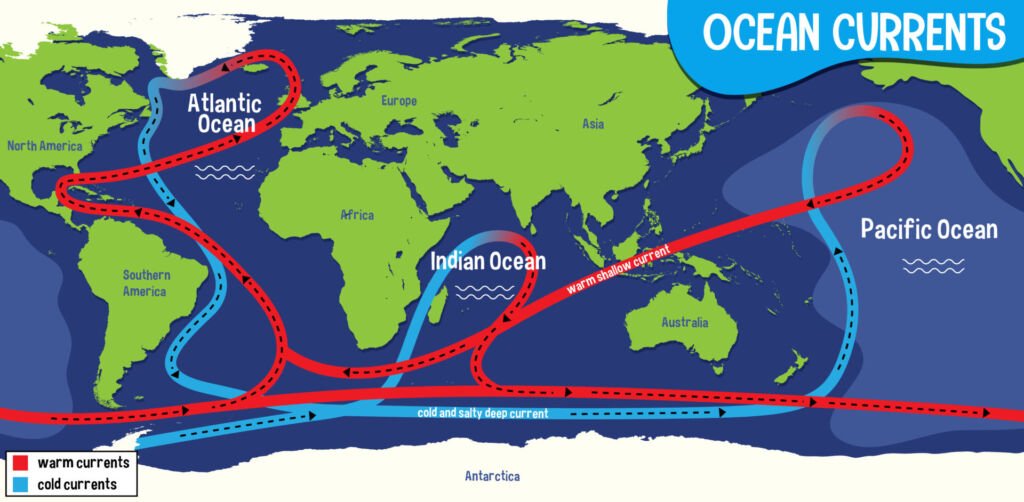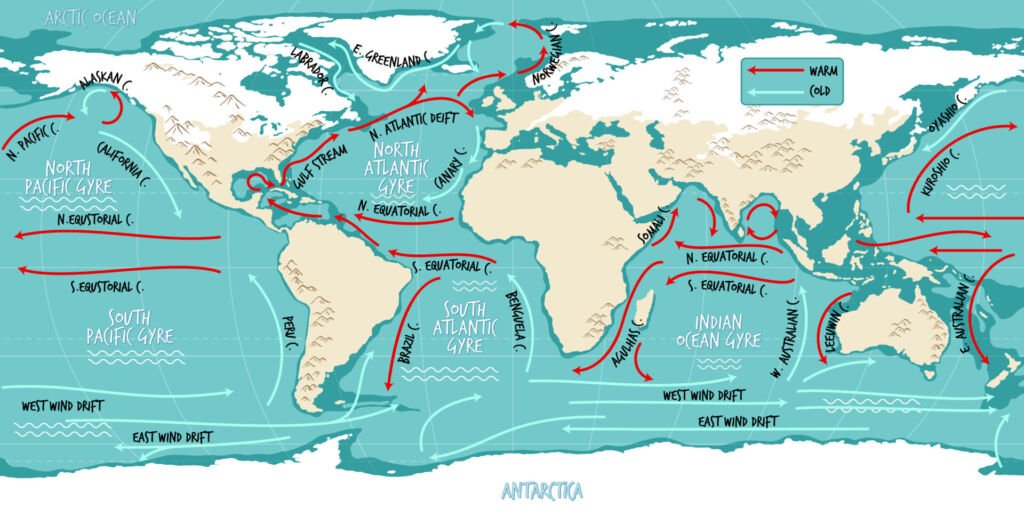Imagine a fisherman in a coastal village noticing a change in water temperature. This seemingly small shift could indicate altered ocean currents, potentially impacting his community’s livelihood and even the weather patterns they’ve known for generations.
⫸ How Ocean Currents Affect Climate?
Ocean currents, massive water movements within Earth’s oceans, play a surprisingly crucial role in shaping our planet’s climate. They act as a vast circulatory system, transporting heat and nutrients throughout the globe. Understanding how ocean currents affect climate is essential for grasping the complexities of our planet’s ever-changing weather patterns.

In this blog post, we’ll explore the world of ocean currents, how they work, and their profound impact on our climate. By the end, you’ll better appreciate the ocean’s hidden power and influence on our lives.
⫸ Unveiling the Ocean's Hidden Hand in Shaping Our World's Climate
Ocean currents are like massive rivers within the ocean, driven by factors like wind, temperature differences, and the Earth’s rotation. They circulate warm and cold water around the globe, carrying immense amounts of heat energy with them. This global-scale circulation is essential to understanding how ocean currents affect climate and why they are crucial in shaping our world.
Let’s dive deeper into how ocean currents and climate are connected. By the end of this section, you’ll understand:
A brief introduction to ocean currents and their global influence
Ocean currents are a complex phenomenon with a seemingly simple premise: ocean water’s continuous, directed movement. These currents can be surface-driven, influenced primarily by winds, or deep water currents, powered by differences in water density. Major current systems circle the globe, creating a dynamic network that impacts climate beyond the ocean’s boundaries. Understanding the mechanisms behind ocean currents is the first step towards grasping their impact on climate.
Highlighting the importance of ocean circulation in climate regulation
Think of ocean currents as the planet’s colossal climate regulator. They play a central role in distributing the sun’s heat around the globe. Warm currents carry heat from the tropics towards the poles, while cold currents transport cooler water towards the equator. This continuous heat exchange helps to moderate global temperatures, preventing extremes that would otherwise make many regions uninhabitable. Ocean currents also significantly influence precipitation patterns, air temperatures, and extreme weather events. Our planet’s climate would drastically differ without the ocean’s circulation system.
⫸ Understanding Ocean Currents: The Forces Behind the Flow
Did you know the ocean contains hidden rivers larger than any on land? These colossal underwater currents shape our planet’s climate in surprising ways.
A brief overview of why understanding ocean currents is crucial to understanding their impact on climate.
The Driving Forces Behind Ocean Circulation
There’s more to ocean currents than meets the eye. Here’s a breakdown of the primary forces propelling these massive water movements:
● Wind Power
- Wind plays a starring role: As it blows across the ocean’s surface, it drags the water along, creating surface currents.
- Powerful winds like trade winds and westerlies drive major current systems, influencing how ocean currents affect climate.

● Density Differences
Water gets denser when it’s cold and salty. This density difference sets up a deep-water conveyor belt:
- Cold, salty water sinks in polar regions, pushing warmer, less dense water out of the way.
- This deep circulation is critical in transporting heat and nutrients, impacting how ocean currents affect climate.
● The Coriolis Effect
- Earth’s spin twists ocean currents uniquely. This ‘Coriolis effect’ deflects currents to the right in the Northern Hemisphere and the left in the Southern Hemisphere.
- This deflection creates large circular ocean currents called gyres.
- Gyres influence climate by shaping how currents distribute heat and impact regional weather patterns.
⫸ The Powerhouse: Major Ocean Current Systems and Their Roles
Imagine a network of colossal rivers surging through the oceans, their flow dwarfing even the mightiest land-based waterways. These major ocean current systems are vital forces shaping our planet‘s climate.
This overview briefly overviews the most significant ocean current systems and their interconnected roles in shaping weather and climate patterns worldwide.
The Great Ocean Conveyor Belt: A Global Thermostat
- The conveyor belt starts in the North Atlantic, where cold, salty water becomes dense and sinks.
- It flows south, deep beneath the ocean, to Antarctica.
- Eventually, it resurfaces and branches out, warming as it travels into the Indian and Pacific Oceans.

● How it transports heat and influences regional climates?
- This system carries warm surface water from the tropics towards the poles, releasing heat.
- The cooler, deeper currents transport cold water back towards the equator, moderating temperatures globally.
- Disruptions to the conveyor belt can have far-reaching consequences for how ocean currents affect climate.
● The process of upwelling and its impact on ocean temperatures
- Wind along coastlines pushes surface water away, causing deeper, colder water to rise and replace it.
- This cold water is rich in nutrients from the ocean floor.
- Upwelling cools surface temperatures in the immediate area.
- The nutrient-rich water fuels the growth of phytoplankton, the base of the marine food web.
- Upwelling zones support some of the world’s most productive fisheries.
Boundary Currents: Shaping Coastal Climates
- Boundary currents run along coastlines and can be either warm or cold, depending on their origin.
- Warm currents (like the Gulf Stream) bring warm, moist air, leading to milder temperatures and more rainfall on nearby land.
- Cold currents (like the California Current) cool the air, leading to drier climates and fog on nearby land.
⫸ The Impact on Climate: A Multifaceted Relationship
Ocean currents profoundly influence our planet’s climate, with far-reaching effects on temperature, rainfall, and the delicate balance of global weather patterns. How ocean currents affect climate is a complex and crucial question.

Imagine the world without ocean currents: scorching heat at the equator, frigid temperatures near the poles, and vast stretches of land rendered uninhabitable. Thankfully, the ocean’s currents prevent this extreme scenario. However, the way ocean currents affect climate goes far deeper.
Ocean Currents and Temperature Regulation
- Ocean currents act as a giant planetary conveyor belt, transporting warm water from the tropics toward the poles and cooler water from the polar regions back toward the equator.
- This heat exchange moderates temperatures, preventing the extremes that would otherwise occur.
- Shifts in ocean currents caused by climate change can disrupt this delicate temperature balance.
- Altered currents can lead to regional warming or cooling, changes in sea level, and more extreme heat waves or cold snaps. Understanding how ocean currents affect climate is vital for predicting these changes.
Shaping Precipitation Patterns:
- Ocean currents affect the temperature and moisture content of the air above them, directly influencing atmospheric circulation patterns.
- Warm currents increase evaporation, adding moisture that can fall as precipitation elsewhere.
- Currents play a major role in determining rainfall distribution:
- Warm currents can bring ample rainfall to coastal regions.
- Cold currents can create dry conditions, contributing to the formation of deserts. The question of how ocean currents affect climate includes this impact on rainfall.
Ocean Currents and Climate Change:
- Warming waters, melting ice caps, and changes in salinity levels can all affect ocean currents.
- Disruptions in the “global conveyor belt” could severely affect climate stability.
- Changes in ocean circulation could lead to:
- More extreme weather events like hurricanes and droughts.
- Shifts in regional climate patterns affecting agriculture and ecosystems.
- Climate change will accelerate further due to altered heat distribution. Closely studying how ocean currents affect climate is essential for mitigating those effects.
⫸ Conclusion
Did you know that a change in ocean currents played a role in the plot of the disaster movie “The Day After Tomorrow”? While the film takes things to the extreme, it highlights the potential for far-reaching consequences when this delicate system is disrupted.
- Ocean currents are climate superheroes: They move massive amounts of heat around the globe, regulating temperatures and making much of our planet habitable.
- Currents shape weather patterns: They directly influence rainfall, atmospheric circulation, and extreme weather events like hurricanes and droughts.
- Climate change is the wild card: Our changing climate has the potential to alter ocean currents, leading to unpredictable and potentially severe consequences for regional climates and global weather stability. Understanding how ocean currents affect climate is crucial for our future.
- Our oceans need protection: Pollution, overfishing, and climate change all threaten to disrupt the delicate balance of ocean ecosystems, including the currents that are crucial to our planet’s health.
- Knowledge is power: Continued research into how ocean currents affect climate is essential for predicting future changes, developing adaptation strategies, and making informed decisions to protect our planet.
- Small actions, big impact: We can contribute to ocean health by reducing pollution, supporting sustainable practices, and advocating for policies that protect our oceans and their vital role in the Earth’s climate.
Let’s work together to safeguard our oceans and ensure a stable climate for ourselves and future generations.

